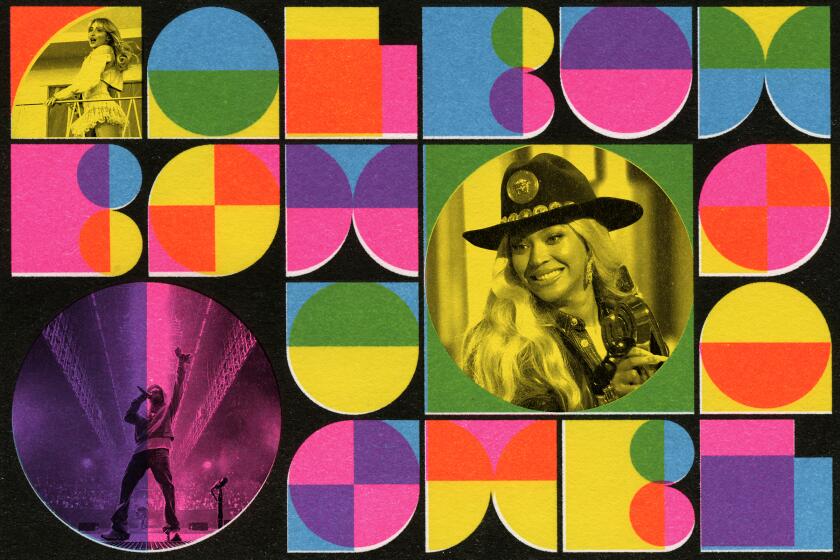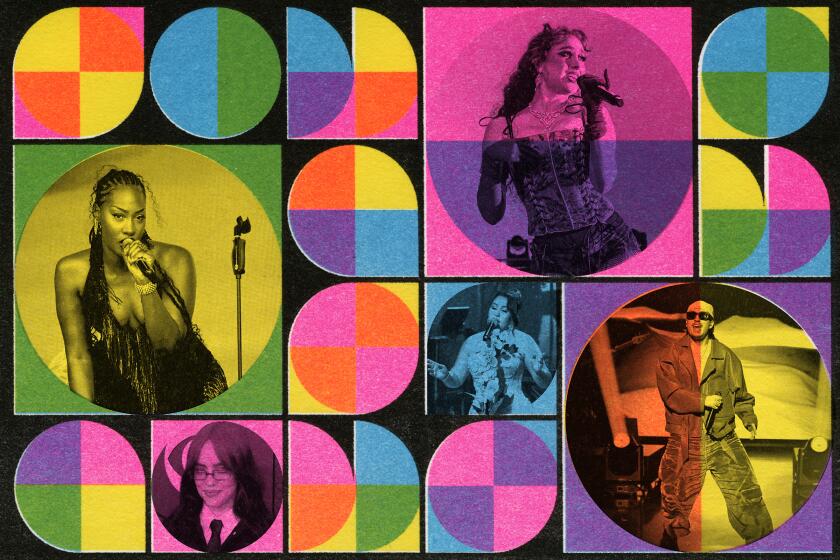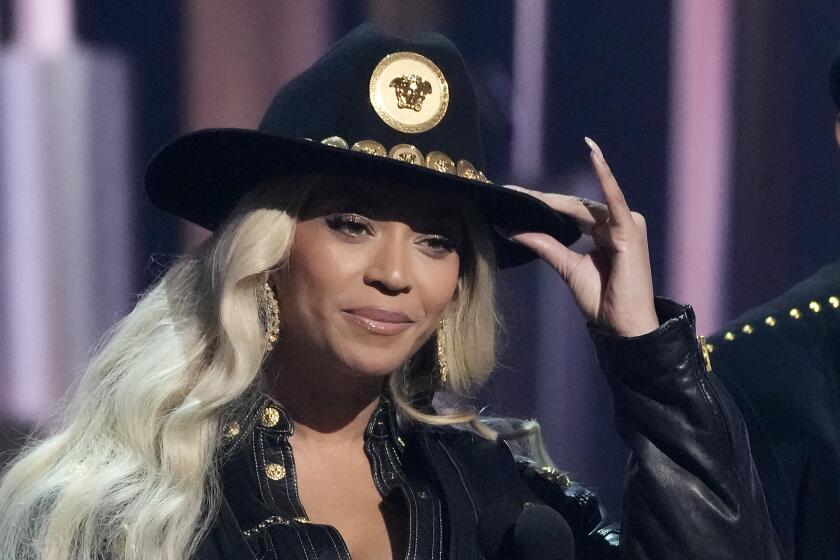Lady Gaga on Coachella, LG7 and the ‘slightly subversive’ ‘Die With a Smile’

- Share via
For all her dedication to expanding — and sometimes to exploding — the boundaries of good taste in pop music, Lady Gaga never goes long without dropping a killer ballad to remind you what a fundamentally talented singer she is.
Think of the countrified “Million Reasons.” Think of the flag-waving “Hold My Hand.” Think, especially, of “Shallow,” her and Bradley Cooper’s Oscar-winning duet from their remake of “A Star Is Born.” Each reveals a different facet of Gaga’s creative persona while showcasing a voice that can blend tenderness and ferocity.
Her latest is another duet, “Die With a Smile,” in which she and Bruno Mars play lovers at the end of the world amid a shimmering yet muscular production that pulls from rock, country and R&B. (The song was written by Gaga, Mars, Andrew Watt, Dernst “D’Mile” Emile II and James Fauntleroy and produced by the singers, Watt and D’Mile.) Released in August, just as Gaga was ramping up promotion for her role in “Joker: Folie à Deux,” “Die With a Smile” has since racked up more than 1.2 billion streams on Spotify. This week it’s the highest-charting nonholiday tune on Billboard’s Hot 100 at No. 6.
John Legend, Willow, St. Vincent, Amy Allen and Daniel Nigro discuss the work that led them to nominations at February’s 67th Grammy Awards.
Now the song is nominated for two prizes at the 67th Grammy Awards in February: pop duo/group performance — which Gaga won in 2019 with “Shallow” and again in 2021 with her and Ariana Grande’s “Rain on Me” — and song of the year, for which she’s been nominated three previous times.
Lady Gaga, who’s 38 and engaged to tech entrepreneur Michael Polansky, spoke about the song — as well as the upcoming album that her fans refer to as LG7 and her booking as a headliner at next year’s Coachella festival — between video shoots this week at a Santa Monica recording studio. She was wearing an elaborate white gown with a long train and pointy shoulders, and her braided blond hair was tucked beneath a headband for a vaguely “Midsommar”-ish look.
My understanding is that “Die With a Smile” grew out of a late-night phone call from Bruno.
We had been talking about working together, and we were trying to figure out what we were gonna do. He called me and he said, “I have this idea.” I really wanted to hear what he was doing, so I went over there really late and he played me the start of this idea. He had a couple different ideas, but I said, “This one is a love song — I think people would love to hear us do a love song.”
What grabbed you in what he had?
It was the lyrics — this idea of a song that was about what we would do if the world was ending. I just remember feeling like it was a song that people needed to hear. I write music all the time, and sometimes you feel like you’re making something that some people will like. But there’s other times that you work on something and you just know it’s gonna deeply speak to all different kinds of people. I knew it right away.
Great chords in this song.
Lush, beautiful chords. Actually, that was one of the first things we did. I sat down at the piano and was like, “OK, Bruno, show me the chords.” I don’t think he knew how much of a musician I was.

You guys recorded it together?
We recorded my part together. Part of the magic of the song is the conversation of it all. I actually don’t like to do collaborations over the phone or over email. We were all in the studio together. I was at the piano when we were writing, and I was trying to really get in his head. And then when I was singing, he took me through every intonation of how he heard it. I had some pretty strong views about the harmonies — I wanted them to be super ’70s.
It’s kind of hard to place the song in time, though the ’70s is definitely part of it.
That harmony in the chorus. I think the music of that time sort of defined what timeless is — a classic, you know? Sometimes when I’m in the studio, I’m intentionally not thinking classic.
You’re trying to envision something that’s never been done.
Yeah, maybe it’s a little bit avant-garde, or it’s odd. I love odd things, but this was more about beauty and sincerity. And it’s smooth.
For me the song evokes a couple of classic duets: Michael McDonald and Patti LaBelle’s “On My Own” and “Endless Love” by Diana Ross and Lionel Richie.
I was thinking about Carole King and James Taylor. There was something so special when they performed together — it was all about what they were saying to each other. But I think “Die With a Smile” is a unique song in a way in 2024. We’re saying some s— that’s maybe not happening on every record.
It certainly doesn’t fit in with what else is on the radio right now.
I don’t think we were worried about that. I like to not fit in.
Check out the 20 best albums of 2024 as selected by Times pop music critic Mikael Wood.
You’ve returned to ballads regularly throughout your career.
I’m thinking of one record I didn’t put on my [upcoming] album that’s actually… I might put it out so I don’t want to share the name. You almost got me [laughs]. It’s actually very fragile and not big — one of the first times I’ve ever done that. But I like big ballads. You can sing along about love in a big way. I love emotional, dramatic music, whether it’s James Taylor and Carole King or it’s David Lee Roth.
How would you define the visual style you and Bruno have adopted for “Die With a Smile”?
We were looking at variety shows and imagining that we were a television couple. But also I said to Bruno, “I’m still gonna be one of the boys.” One of the great honors of being on a song with Bruno Mars is the way he regards me. I didn’t want to just be the wife. So in the video, she kind of takes matters into her own hands. You also get the feeling that this is a couple that’s been doing this for a long time. This was really the first time Bruno and I ever did anything, so isn’t it interesting that it feels like we’ve sung together before?
You’re both pros.
Yeah, but sometimes it doesn’t happen that way. There’s a naturalness — he’s like a brother. We both love to rehearse too. That’s something we have in common.
In the video you’re smoking a cigarette until the last possible second before your verse.
I wanted to create the semblance of a character who had something to say. And it’s slightly subversive — like, you’re talking about the world ending and I’m having a cigarette. There’s something kind of dark about it.

The way this song dropped into the world made me wonder about a connection to “Joker” or to “Harlequin,” the album of jazz standards you made to accompany the movie. In your mind, does “Die With a Smile” exist in that world?
I don’t think so. I mean, this was not meant to be for that. But that was happening in my life at the time we wrote it and made it, so it’s hard to say no entirely because these things always ricochet off each other. I do think that the humor we found in the video must have been something that was bouncing around inside me — this idea of a sad story that has some comedy. Singing about dying is not something you would associate with smiling, but somehow it all makes sense when you think about the sweetness of what we’re trying to say.
Is the song connected to whatever’s happening on LG7?
Absolutely. “Die With a Smile” is on my record — it’s a huge part of my album. It was like this missing piece. The record is full of my love of music — so many different genres, so many different styles, so many different dreams. It leaps around genre in a way that’s almost corrupt. And it ends with love. That’s the answer to all the chaos in my life is that I find peace with love. Every song that I wrote, I just kept getting kind of swept away in these different dreams I was having about the past — almost like a recollection of all these bad decisions that I made in my life. But it ends in this very happy place.
You’re headlining Coachella in April, which will be your second time there after performing in 2017. When the announcement came out, you said, “I’ve had a vision I’ve never been able to fully realize at Coachella” and that you’ve “been wanting to go back and to do it right.” Can you elaborate?
Well, for reasons totally outside of my control, there was a cancellation —
Beyoncé pulled out in 2017 because she was pregnant, and you stepped in.
I really wanted to be there for music fans, and at the time there was all this excitement to be able to film bits of “A Star Is Born” at Coachella. But I only had two weeks [to prepare for the show]. And so to design a stage, to have it made, all of those things — I didn’t have the time to totally do what I really wanted to do. I love music. I love performing. I love music fans. And I was so excited to film pieces of our movie there. So I did it, and I loved it. But you know when you have a vision in your mind of how you want to do something? It’s time to make it happen.
Listen to a playlist of the best songs of the year as selected by The Times’ August Brown and Mikael Wood.
What’s your vibe on music festivals?
Music festivals to me are part of the community of music. I used to go to Bonnaroo a lot, actually, when I was younger. It’s a place to just put pause on everything for a minute. You fall into everybody around you, and you fall into the music and the lights. I don’t think there’s anything that’s affected me as deeply in my life as live music. There’s something for me that’s religion about it.
You played the final dates of your jazz show in Las Vegas in July. Think you’ll do it again?
I’m definitely gonna be singing jazz in the future, for sure. Jazz is just this huge part of my heart. I loved it my whole life, and it was so exciting when I got to do it with Tony [Bennett]. And I loved making “Harlequin” — that was really a special, special experience. Arranging that music is a real process. Finding the right sound is a real process.
There’s something slightly manic to my ears about “Harlequin.”
“Manic” is the right word. There’s surf-punk influence on the album. There’s doom-jazz influence on the album. There’s New Orleans influence on the album. It was through the lens of a woman that wants to be whoever she wants whenever she feels like it — a woman that will light the stage on fire if she feels like it. In a way, it was kind of defiant: When I’ve sung jazz for most of my career, I think that some people really loved it and other people never understood why I deviated to other genres. The beauty of why I make records is I love learning about music. I loved working with Tony. I loved making “Harlequin.” I loved collaborating with all the DJs and Gesaffelstein on my new album. I loved learning about industrial music and about all the different crevices of electronic music, and then I loved working with Bruno. One of the things I’ve probably been judged for in my career was not sticking to one thing. But not sticking to one thing is my life force.
More to Read
The biggest entertainment stories
Get our big stories about Hollywood, film, television, music, arts, culture and more right in your inbox as soon as they publish.
You may occasionally receive promotional content from the Los Angeles Times.














